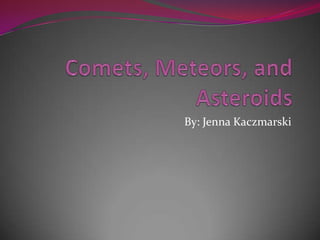Comets, meteors, and asteroids
- 1. Comets, Meteors, and AsteroidsBy: Jenna Kaczmarski
- 2. CometsComets have been around since the beginning of time so scientists do not know who first founded the Comet. Comets are small icy masses in our solar system and are fairly small, about 10 miles across. They are usually larger than a Meteoroid and have a range of orbital periods, ranging from a few years to hundreds of years. Short orbital period comets usually are beyond the orbit of Neptune, while long orbital period comets are near the Oort Cloud, a number of comets that orbit the sun.
- 3. Comets ContinuedThe central part of the comet is referred to as the Comet Nucleus and is composed of rock, dust and frozen gases. When the comet is heated by the Sun, also known as solar radiation, it constructs an atmosphere surrounding the nucleus forming a coma or tail. Comets are small compared to planets, but are a large part of our solar system.
- 4. Meteors Meteors have a range of sizes, from a grain of sand to a baseball and are made of particles of dust. The largest meteors usually come from part of an asteroid. Small and large meteors take part in meteor showers, they occur when streams of cosmic debris (meteors) enter the Earthâs atmosphere at high speeds. Most people call these meteors âshooting starsâ.
- 5. Meteors ContinuedThe highest number of meteors recorded were 10-15 per second in 1833. This meteor shower was called the Leonid shower and occurs every year around November. Meteors fascinate everyone in the world and they are a beautiful part of the universe.
- 6. AsteroidsThe first asteroid to be discovered was found January 1, 1801 by Giuseppi Piazzi. He called the asteroid Ceres based off a Greek hero. This is the largest asteroid to date at 485 miles long. Asteroids are the rocky remains of the formation of our solar system from 4.6 billion years ago. Most asteroids orbit the sun and are found in the asteroid belt between Mars and Jupiter.
- 7. Asteroids Continued They can range from hundreds of feet to hundreds of miles in diameter. Although asteroids were formed the same way as the planets they donât have an atmosphere or moons. There are three main types of Asteroids, C-type, the darkest type, M- type, which is the brightest because it reflects off the sun, and S-type, which contain silicate and are found in the inner part of the asteroid belt.
- 8. The Moon The moons effects our planet in many ways. From giving light in the night, to changing the tide it impacts us in many ways. The moons position effects the light it gives us during the night, for instance when the moon orbits and it is facing the sun the moon it reflects and gives us more light. Also with the gravitational pull of the moon its position affects the tide. As it passes over the oceans it exerts a pulling force creating areas of slightly higher water which we call high tide.
- 10. The MoonBased off the pictures in the previous slide, the moons phases are New, Waning Crescent, Third Quarter, Waning Gibbous, Full, Waxing Gibbous, First Quarter, and Waxing Crescent. Also in the second picture, it shows how a Lunar eclipse is formed. A lunar eclipse occurs when the moon passes behind the Earth (the Earth is between the moon and the sun, the eclipse is the Earth's shadow on the moon). There is also such thing as a Solar Eclipse and that is formed when the moon passes directly between the sun and the earth.
- 11. AnalysisIf the Earth had a second moon what would the effect on us be?Based off the information I have gathered the influence the second moon would have would depend on the size. If it was large, we would have much bigger tides, if it was smaller we would have small tides. Also there would be more solar eclipses, because with two moons they would line up with the sun more causing more solar eclipses.
- 12. Bibliography " Meteor Showers - Meteor Shower - Meteors - January 2011 - MeteorBlog.com." Meteor Showers - Meteor Shower - Meteors - January 2011 - MeteorBlog.com. N.p., n.d. Web. 12 Jan. 2011. <http://www.meteorblog.com/>." http://boojum.as.arizona.edu/~jill/NS102_2006/Lectures/Lecture13/halebopp_gleason_big.jpg.". N.p., n.d. Web. 12 Jan. 2011. /~jill/NS102_2006/Lectures/Lecture13/halebopp_gleason_big.jpg&imgrefurl=http://boojum.as.arizona.edu/~jill/NS102_2006/Lectures/Lecture13/comets.html&usg=__U4VmwbaoXvZG76PxQYjcCXyRNZ4=&h=730&w>."http://www.freakygossip.com/wp-content/uploads/2010/08/Meteor-Shower-August-2010.jpg." N.p., n.d. Web. 12 Jan. 2011. <http://www.google.com/imgres?imgurl=http://www.freakygossip.com/wp-content/uploads/2010/08/Meteor-Shower-August-2010.jpg&imgrefurl=http://www.freakygossip.com/2010/08/perseid-meteor-shower-2010-tonight-video-shooting-stars-world-absence-moon/&usg=__XfIcfk>. http://www.freakygossip.com/wp-content/uploads/2010/08/Meteor-Shower-August-2010.jpg." Google. N.p., n.d. Web. 12 Jan. 2011. <http://www.google.com/imgres?imgurl=http://www.freakygossip.com/wp-content/uploads/2010/08/Meteor-Shower-August-2010.jpg&imgrefurl=http://www.freakygossip.com/2010/08/perseid-meteor-shower-2010-tonight-video-shooting-stars-world-absence-moon/&usg=__XfIcfk>. http://www.solcomhouse.com/images/asteroid_compare.jpg." Google. N.p., n.d. Web. 12 Jan. 2011.?imgurl=http://www.solcomhouse.com/images/asteroid_compare.jpg&imgrefurl=http://www.solcomhouse.com/asteroids.htm&usg=__FijPE4vgs909tfyYYCRFmIfFzEg=&h=495&w=630&sz=82&hl=en&start=0&sig2=6qvbAFEXM-wS8ffziazhqQ&zoom=1&tbnid=i-atk>.
- 13. Bibliography"Asteroid Facts - Explore the Cosmos | The Planetary Society." The Planetary Society. N.p., n.d. Web. 12 Jan. 2011. <http://www.planetary.org/explore/topics/asteroids_and_comets/facts.html>. "Asteroids and Comets, Asteroids and Comets Information, Facts, News, Photos -- National Geographic." Science and Space Facts, Science and Space, Human Body, Health, Earth, Human Disease - National Geographic. N.p., n.d. Web. 12 Jan. 2011. <http://science.nationalgeographic.com/science/space/solar-system/asteroids-comets-article.html>. "Comets." Windows to the Universe. N.p., n.d. Web. 12 Jan. 2011. <http://www.windows2universe.org/comets/comets.html>. "Interesting Facts About Asteroids." Universe Today. N.p., n.d. Web. 12 Jan. 2011. <http://www.universetoday.com/33406/interesting-facts-about-asteroids/>. century, the middle of the twentieth, this model suffered from a number of shortcomings: in particular, and Fred Lawrence Whipple. "Comet - Wikipedia, the free encyclopedia." Wikipedia, the free encyclopedia. N.p., n.d. Web. 12 Jan. 2011. <http://en.wikipedia.org/wiki/Comet>. planets, crusts of the terrestrial. "Meteors l Meteorites and Impacts." The Nine Planets Solar System Tour. N.p., n.d. Web. 12 Jan. 2011. <http://nineplanets.org/meteorites.html>.












